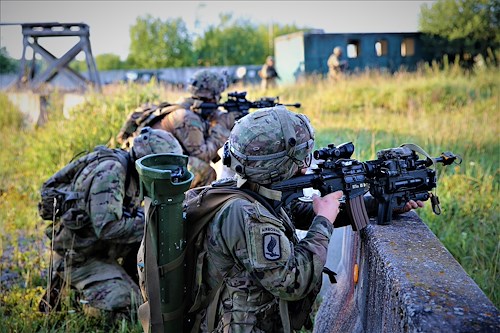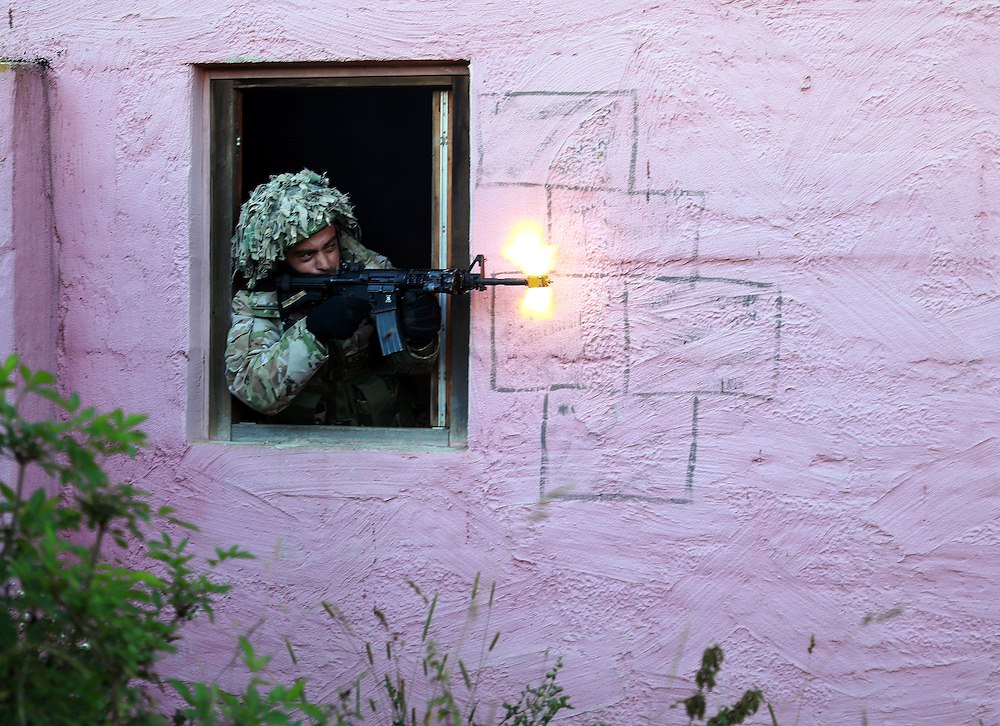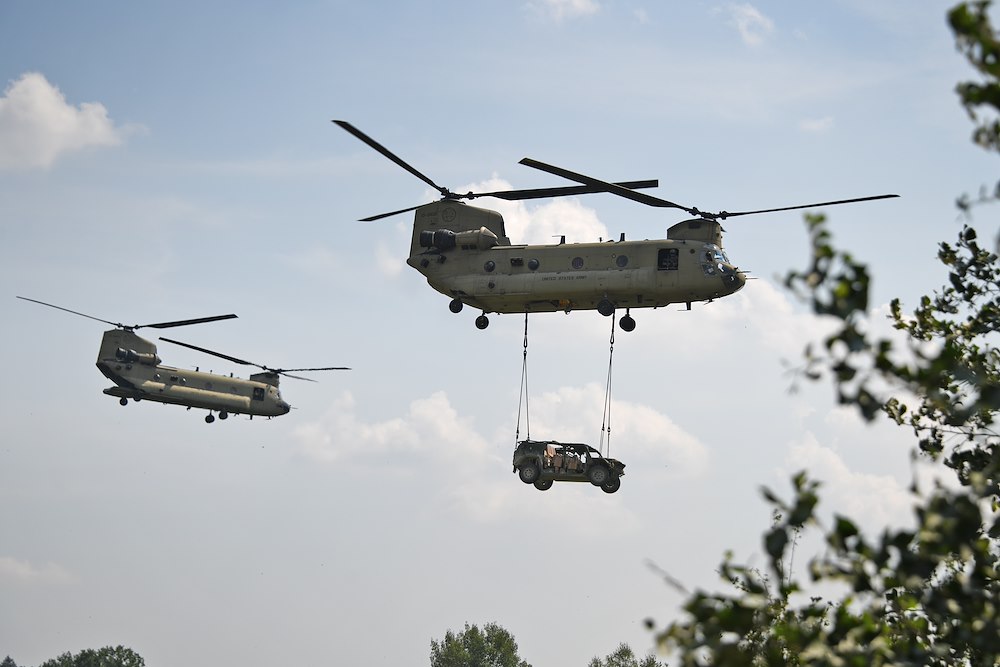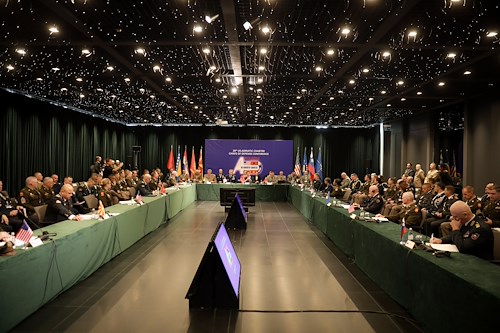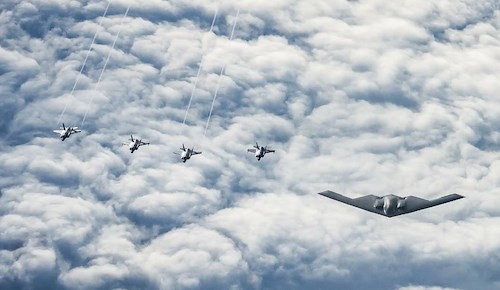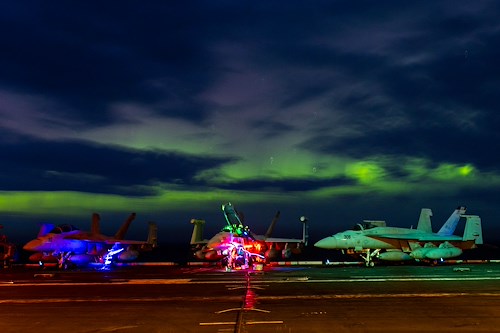Gallery contains 7 images
×
Photo 1 of 7
Joint Multinational Readiness Ce
U.S. Army Paratroopers assigned to the 173rd Airborne Brigade conduct combat operations during Saber Junction 20 on Aug. 20, 2020. Saber Junction 20 is a 7th Army Training Command-conducted, U.S. Army Europe-directed annual exercise designed to assess the readiness of the U.S. Army's 173rd Airborne Brigade to execute unified land operations in a joint, combined environment, and to promote interoperability with participating allies and partner nations. This year's exercise will take place primarily at 7ATC's Grafenwoehr and Hohenfels Training Areas in Bavaria. U.S. military forces stationed in Europe routinely conduct these types of exercises with allied and partner nations to enhance interoperability and readiness. (U.S. Army photo by Cpl. Shawn Pierce)
Photo by: Cpl. Shawn Pierce
Photo 2 of 7
Joint Multinational Readiness Ce
Soldiers assigned to the 1st Battalion 4th Infantry Regiment operate a T 72 main battle tank during Exercise Saber Junction 20 at the Hohenfels Training Area, Germany, Aug. 24, 2020.
Saber Junction 20 is a 7th Army Training Command-conducted, U.S. Army Europe-directed annual exercise designed to assess the readiness of the U.S. Army’s 173rd Airborne Brigade to execute unified land operations in a joint, combined environment, and to promote interoperability with participating allies and partner nations. This year’s exercise will take place primarily at 7ATC’s Grafenwoehr and Hohenfels Training Areas in Bavaria. U.S. military forces stationed in Europe routinely conduct these types of exercises with allied and partner nations to enhance interoperability and readiness.
(U.S. Army photo by Sgt. Thomas Stubblefield)
Photo by: Sgt. Thomas Stubblefield
Photo 3 of 7
Joint Multinational Readiness Ce
U.S. Army Sgt. Derek Born from Charlie Company, 1st Battalion, 214th Aviation Regiment loads a casualty in a HH-60 Blackhawk helicopter at a mass casualty exercise during Saber Junction 20, Aug. 15, 2020, at Hohenfels Training Area. Saber Junction 20 is a 7th Army Training Command-conducted, U.S. Army Europe-directed annual exercise designed to assess the readiness of the U.S. Army’s 173rd Airborne Brigade to execute unified land operations in a joint, combined environment, and to promote interoperability with participating allies and partner nations. This year’s exercise will take place primarily at 7ATC’s Grafenwoehr and Hohenfels Training Areas in Bavaria. U.S. military forces stationed in Europe routinely conduct these types of exercises with allied and partner nations to enhance interoperability and readiness. (U.S. Army photo by Sgt. 1st Class Garrick W. Morgenweck)
Photo by: Sgt. 1st Class Garrick Morgenwec
Photo 4 of 7
Joint Multinational Readiness Ce
A Georgian soldier engages from a window during Exercise Saber Junction 20 at the Hohenfels Training Area, Germany, Aug. 20, 2020.Saber Junction 20 is a 7th Army Training Command-conducted, U.S. Army Europe-directed annual exercise designed to assess the readiness of the U.S. Army’s 173rd Airborne Brigade to execute unified land operations in a joint, combined environment, and to promote interoperability with participating allies and partner nations. (U.S. Army photo by Sgt. Thomas Stubblefield)
Photo by: Sgt. Thomas Stubblefield
Photo 5 of 7
173rd Airborne Brigade
A Romanian Soldier from 2nd Infantry Battalion Călugăreni, 1st Brigade Argedava training alongside the 173rd Airborne Brigade and 1st Battalion, 4th Infantry Regiment gives commands to her squad leaders while assaulting an envelopment area during a battalion engagement Aug. 16, 2020 as part of Exercise Saber Junction 20. This exercise is taking place at the Joint Multinational Training Center in the Hohenfels Training Area, Germany from Aug. 10 to Aug. 26, 2020.
Saber Junction 20 is a 7th Army Training Command-conducted, U.S. Army Europe-directed annual exercise designed to assess the readiness of the U.S. Army's 173rd Airborne Brigade to execute unified land operations in a joint, combined environment, and to promote interoperability with participating ally and partner nations. For more information, go to https://www.dvidshub.net/feature/SaberJunction
The 173rd Airborne Brigade is the U.S. Army's Contingency Response Force in Europe, providing rapidly deployable forces to the United States European, African and Central Command areas of responsibility. Forward deployed across Italy and Germany, the brigade routinely trains alongside NATO allies and partners to build partnerships and strengthen the alliance.
(U.S. Army photo by Sgt. John Yountz)
Photo by: Sgt. John Yountz
Photo 6 of 7
Joint Multinational Readiness Ce
Paratroopers assigned to the 173rd Airborne Brigade pull security while wearing chemical protective masks during Exercise Saber Junction 20 at the Hohenfels Training Area, Germany, Aug. 24, 2020.
Saber Junction 20 is a 7th Army Training Command-conducted, U.S. Army Europe-directed annual exercise designed to assess the readiness of the U.S. Army’s 173rd Airborne Brigade to execute unified land operations in a joint, combined environment, and to promote interoperability with participating allies and partner nations. This year’s exercise will take place primarily at 7ATC’s Grafenwoehr and Hohenfels Training Areas in Bavaria. U.S. military forces stationed in Europe routinely conduct these types of exercises with allied and partner nations to enhance interoperability and readiness.
(U.S. Army photo by Sgt. Thomas Stubblefield)
Photo by: Sgt. Thomas Stubblefield
Photo 7 of 7
Training Support Activity Europe
U.S. Army CH-47 Chinook helicopters assigned to B Company, 1st General Support Aviation Battalion, 214th Aviation Regiment, 12th Combat Aviation Brigade carrying U.S. Paratroopers assigned to 173rd Airborne Brigade and sling load lift off during Exercise Saber Junction at the 7th Army Training Command's Grafenwoehr Training Area, Germany, August 10, 2020. Saber Junction 20 is a 7th Army Training Command-conducted, U.S. Army Europe-directed annual exercise designed to assess the readiness of the U.S. Army's 173rd Airborne Brigade to execute unified land operations in a joint, combined environment, and to promote interoperability with participating allies and partner nations. This year's exercise will take place primarily at 7ATC's Grafenwoehr and Hohenfels Training Areas in Bavaria. U.S. military forces stationed in Europe routinely conduct these types of exercises with allied and partner nations to enhance interoperability and readiness.
(U.S. Army photo by Gertrud Zach)
GRAFENWOEHR, Germany – Exercise Saber Junction 20 finished as the 173rd Airborne Brigade, 12th Combat Aviation Bde., and multinational allies and partners executed the final battle, Aug. 22-23, at Hohenfels Training Area, Germany.
“Training alongside our allies and partners is a fundamental mission of our brigade,” said Col. Kenneth Burgess, 173rd Airborne Bde. commander. “As the only forward deployed airborne brigade in the U.S. Army, and the Army Contingency Response Force brigade for U.S. Army Europe, our deployments will inevitably find us fighting alongside an ally.
“The more familiar we are with integrating into different systems, the more prepared we will be to win ground combat against a near-peer enemy when directed.”
Saber Junction 20 is a 7th Army Training Command-conducted, U.S. Army Europe-directed annual exercise designed to assess the readiness of the U.S. Army’s 173rd Airborne Bde. to execute unified land operations in a joint, combined environment and to promote interoperability with participating ally and partner nations.
The exercise exemplified 7th ATC’s ability to build and enable real-time readiness as the training event brought multiple U.S. military units and multinational forces together under the Joint Multinational Readiness Center’s direction at the Hohenfels Training Area.
JMRC, one of 7th ATC’s directorates, operates the U.S. Army’s only Europe-based combat training center and provides a realistic, complex operational environment for training audiences.
For Saber Junction 20, JMRC leaders executed a rotational design change that increased unit readiness through the exercise’s five battle periods in August.
"The five battle periods [in Saber Junction 20] allowed for enhanced competition, increased repetition and retraining across the span of 15 days. This facilitated innovation and creativity on the part of everyone involved," said Command Sgt. Maj. Wendell Franklin, the JMRC Operations Group senior enlisted leader.
Participating units experienced dynamic training with JMRC’s opposing forces, or OPFOR, personnel and observer/coach-trainer teams during Saber Junction 20.
OPFOR personnel trained participants in all warfighting functions.
The O/C-T teams observed, coached and trained exercise participants during the planning, preparation and execution phases of simulated combat operations at JMRC.
Together, these capabilities and the new rotational design change enhanced training for exercise participants.
“The new format of Saber Junction 20 allowed our paratroopers to work through the entire orders process, rehearse that plan and then execute it,” said Burgess.
“The pace still stressed our leaders and formations but resulted in steady improvement in the unit's planning and execution.”
The 173rd Airborne Bde. also increased their interoperability with other U.S. military units during the exercise.
The exercised kicked off with a joint force infiltration assault into Hohenfels Training Area as Soldiers were transported by MV-22 Ospreys from the 22nd Marine Expeditionary Unit.
“We had the opportunity to train on the U.S. Marine Corps’ MV-22 Osprey, a new platform for us that provided vital long-distance air transportation for our air assault infiltration into the training area,” said Burgess.
The 173rd Airborne Bde. also reinforced their interoperability with the 12th CAB as both its 1st Battalion, 214th Aviation Regiment (General Support), and 1st Bn., 3rd Avn. Regt., provided air support to the exercise.
“Our habitual relationship with the 173rd Airborne Bde. ensured rapid air-ground integration and enabled aviation to provide a dimensional advantage to the maneuver force,” said Lt. Col. Matthew McGraw, commander of the 1st Bn., 214th GSAB.
According to McGraw, the exercise enabled the battalion to validate mission command systems, complete complex air assaults, execute casualty and medical evacuations, and conduct aerial attack missions.
Elements of the 1st Bn., 3rd Aviation Regt., provided Apache helicopters for close air support of ground troops.
More than 4,000 participants from the U.S. and ally and partner nations participated in the exercise at Grafenwoehr and Hohenfels training areas in August, including Albania, Georgia, Latvia, Lithuania, Moldova, North Macedonia, Romania and Ukraine.
For more information about Saber Junction 20, visit www.7atc.army.mil/SaberJunction/.

